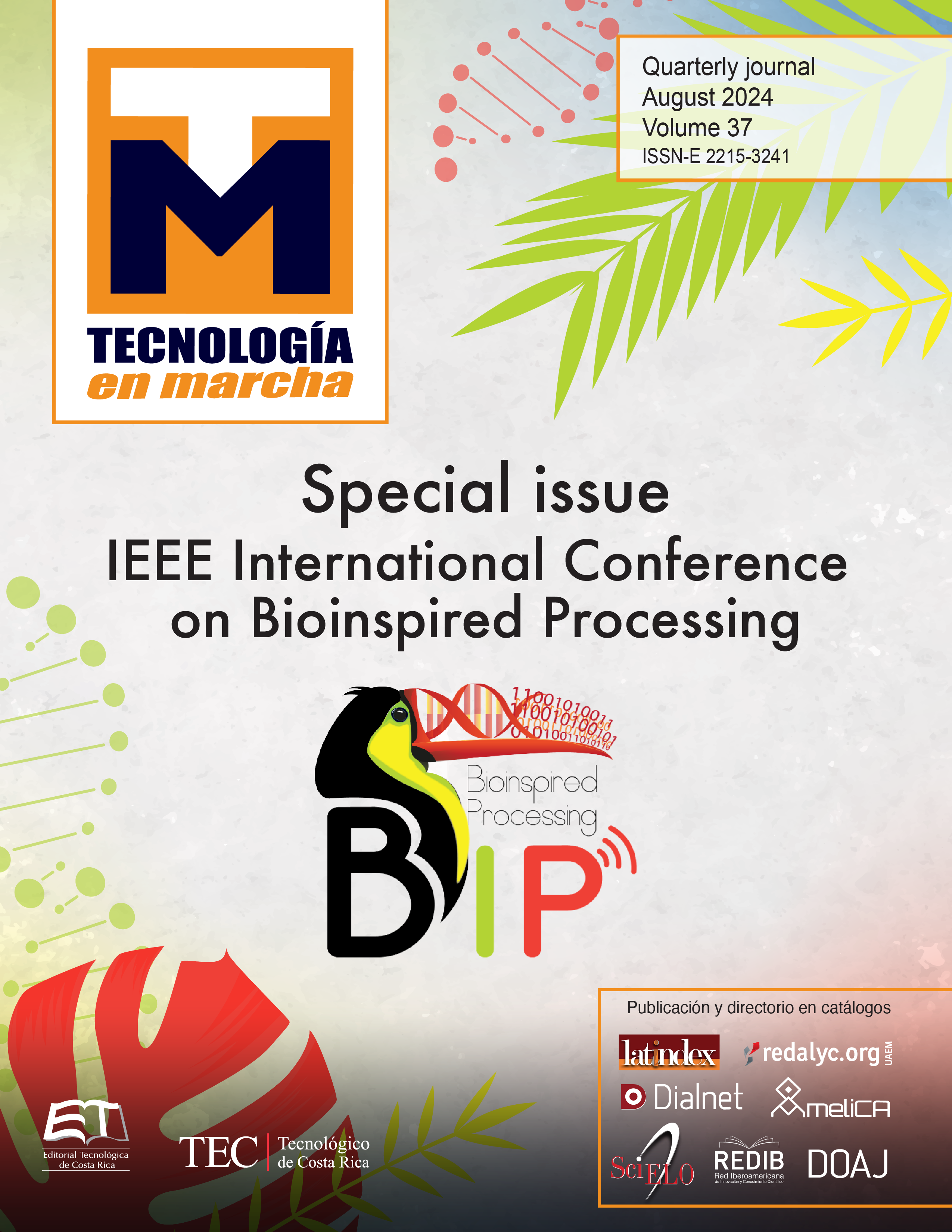Propuesta de aprendizaje auto-semi supervisado para la clasificación desequilibrada de datos tabulares de enfermedades coronarias
Contenido principal del artículo
Resumen
Triple Mixup es una política de aumento en el espacio latente oculto que introdujimos en
el marco de aprendizaje autosupervisado de Mixup contrastivo, para abordar el problema
de datos desequilibrados, para el conjunto de datos tabulares de enfermedades cardíacas
cardiovasculares. Se sabe que los conjuntos de datos tabulares médicos presentan desafíos
como muestras de calidad anotada limitada y de clase altamente desequilibrada debido a la
naturaleza del dominio. La literatura reciente sobre el aprendizaje autosupervisado y semi
supervisado ha mostrado un enorme progreso en el aprendizaje de representaciones útiles y
en el aprovechamiento de conjuntos de datos no etiquetados y conjuntos de datos etiquetados
para entrenar un modelo de aprendizaje. La mayoría de los métodos existentes no son factibles
para datos tabulares debido al esquema de aumento de datos. Además, el problema de
alto desequilibrio puede mostrar un rendimiento más bajo en los algoritmos de aprendizaje
automático. Para este trabajo, proponemos el método de aumentación de datos triple en el
espacio oculto para atacar el desafío desequilibrado en el aprendizaje autosupervisado y semi
supervisado, desde las posibles aplicaciones de Contrastive Mixup, por ende estudiaremos la
influencia de este .
Detalles del artículo

Esta obra está bajo una licencia internacional Creative Commons Atribución-NoComercial-SinDerivadas 4.0.
Los autores conservan los derechos de autor y ceden a la revista el derecho de la primera publicación y pueda editarlo, reproducirlo, distribuirlo, exhibirlo y comunicarlo en el país y en el extranjero mediante medios impresos y electrónicos. Asimismo, asumen el compromiso sobre cualquier litigio o reclamación relacionada con derechos de propiedad intelectual, exonerando de responsabilidad a la Editorial Tecnológica de Costa Rica. Además, se establece que los autores pueden realizar otros acuerdos contractuales independientes y adicionales para la distribución no exclusiva de la versión del artículo publicado en esta revista (p. ej., incluirlo en un repositorio institucional o publicarlo en un libro) siempre que indiquen claramente que el trabajo se publicó por primera vez en esta revista.
Citas
M. Tan, R. Pang, and Q. V. Le, “EfficientDet: Scalable and efficient object detection,” in Proceedings of the
IEEE Computer Society Conference on Computer Vision and Pattern Recognition, 2020, pp. 10 778–10 787.
K. He, G. Gkioxari, P. Dollar, and R. Girshick, “Mask R-CNN,” ´ IEEE Transactions on Pattern Analysis and
Machine Intelligence, vol. 42, no. 2, pp. 386–397, 2020.
A. Bochkovskiy, C. Y. Wang, and H. Y. M. Liao, “YOLOv4: Optimal Speed and Accuracy of Object Detection,”
Proceedings of the IEEE Computer Society Conference on Computer Vision and Pattern Recognition, 2020.
S. Ren, K. He, R. Girshick, and J. Sun, “Faster R-CNN: Towards Real-Time Object Detection with Region
Proposal Networks,” IEEE Transactions on Pattern Analysis and Machine Intelligence, vol. 39, no. 6, pp.
–1149, 2017.
Z. Q. Zhao, P. Zheng, S. T. Xu, and X. Wu, “Object Detection with Deep Learning: A Review,” IEEE Transactions
on Neural Networks and Learning Systems, vol. 30, no. 11, pp. 3212–3232, 2019.
D. Snow, “DeltaPy: A Framework for Tabular Data Augmentation in Python,” SSRN Electronic Journal, pp. 1–3,
B. Sathianarayanan, Y. C. Singh Samant, P. S. Conjeepuram Guruprasad, V. B. Hariharan, and N. D. Manickam,
“Feature-based augmentation and classification for tabular data,” CAAI Transactions on Intelligence
Technology, vol. 7, no. 3, pp. 481–491, 2022.
G. Somepalli, M. Goldblum, A. Schwarzschild, C. B. Bruss, and T. Goldstein, “Saint: Improved neural networks
for tabular data via row attention and contrastive pre-training,” 6 2021. [Online]. Available: http://arxiv.org/
abs/2106.01342
J. Yoon, Y. Zhang, J. Jordon, and M. van der Schaar, “Vime: Extending the success of self-and semi-supervised learning to tabular domain,” Advances in Neural Information Processing Systems, vol. 33, pp. 11 033–11
, 2020.
M. Hyun, J. Jeong, and N. Kwak, “Class-imbalanced semi-supervised learning,” 2 2020. [Online]. Available:
http://arxiv.org/abs/2002.06815
S. Darabi, S. Fazeli, A. Pazoki, S. Sankararaman, and M. Sarrafzadeh, “Contrastive mixup: Self- and semisupervised learning for tabular domain,” 2021. [Online]. Available: http://arxiv.org/abs/2108.12296
X. Li, L. Khan, M. Zamani, S. Wickramasuriya, K. W. Hamlen, and B. Thuraisingham, “Mcom: A semi-supervised
method for imbalanced tabular security data” in IFIP Annual Conference on Data and Applications Security and
Privacy. Springer, 2022, pp. 48–67.
A. Jaiswal, A. R. Babu, M. Z. Zadeh, D. Banerjee, and F. Makedon, “A survey on contrastive self-supervised
learning,” 10 2020. [Online]. Available: http://arxiv.org/abs/2011.00362
T. Chen, S. Kornblith, M. Norouzi, and G. Hinton, “A simple framework for contrastive learning of visual representations,” 2 2020. [Online]. Available: http://arxiv.org/abs/2002.05709
P. M. Tripathi, A. Kumar, R. Komaragiri, and M. Kumar, A Review on Computational Methods for Denoising and
Detecting ECG Signals to Detect Cardiovascular Diseases. Springer Netherlands, 2022, vol. 29, no. 3. [Online].
Available: https://doi.org/10.1007/s11831-021-09642-2
A. Subas, E. Alickovic, and J. Kevric, “Diagnosis of chronic kidney disease by using random forest,” IFMBE
Proceedings, vol. 62, no. 3, pp. 589–594, 2017.
W. Deng, Z. Huang, J. Zhang, and J. Xu, “A Data Mining Based System for Transaction Fraud Detection,”
IEEE International Conference on Consumer Electronics and Computer Engineering, ICCECE 2021,pp.
–545, 2021.
D. Krishnani, A. Kumari, A. Dewangan, A. Singh, and N. S. Naik, “Prediction of coronary heart disease using
supervised machine learning algorithms,” IEEE Region 10 Annual International Conference, Proceedings/
TENCON, vol. 2019-Octob, pp. 367–372, 2019.
H. Yang, “Coronary heart disease historical data,” 2022. [Online]. Available: https://dx.doi.org/10.21227/eapxt883
T. Chen, S. Kornblith, M. Norouzi, and G. E. Hinton, “A simple framework for contrastive learning of visual
representations,” CoRR, vol. abs/2002.05709, 2020. [Online]. Available: https://arxiv.org/abs/2002.05709
K. He, H. Fan, Y. Wu, S. Xie, and R. Girshick, “Momentum contrast for unsupervised visual representation
learning,” 2019. [Online]. Available: https://arxiv.org/abs/1911.05722

